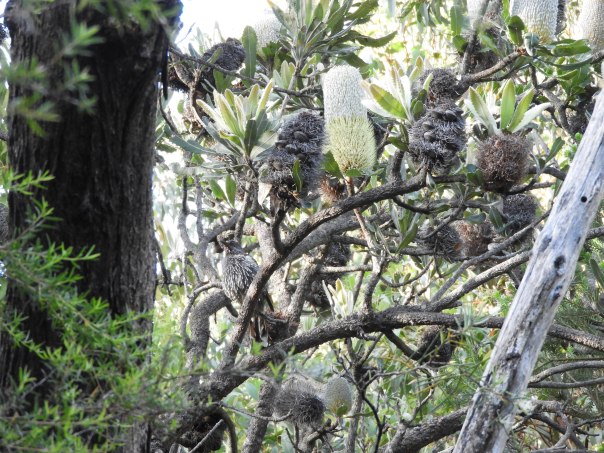Blog Archives
Little Wattlebird bathing in the tree tops
A Little Wattlebird, high in the gum trees, dives through the leaves. I’ve seen birds doing this a few times. They’re taking advantage of the early-morning dew to freshen up their feathers.
Here’s a still photo of the Little Wattlebird:

Common name: Little Wattlebird
Scientific name: Anthochaera chrysoptera
Approximate length: 30 cm
Date spotted: 1 April 2024 (autumn)
Location: Manly Dam Park, New South Wales, Australia: 33°46’39.6″S 151°14’55.7″E
Little Wattlebird on Old Man Banksia
In the early morning light, this Little Wattlebird sits among the sunlit leaves of an Old Man Banksia tree.
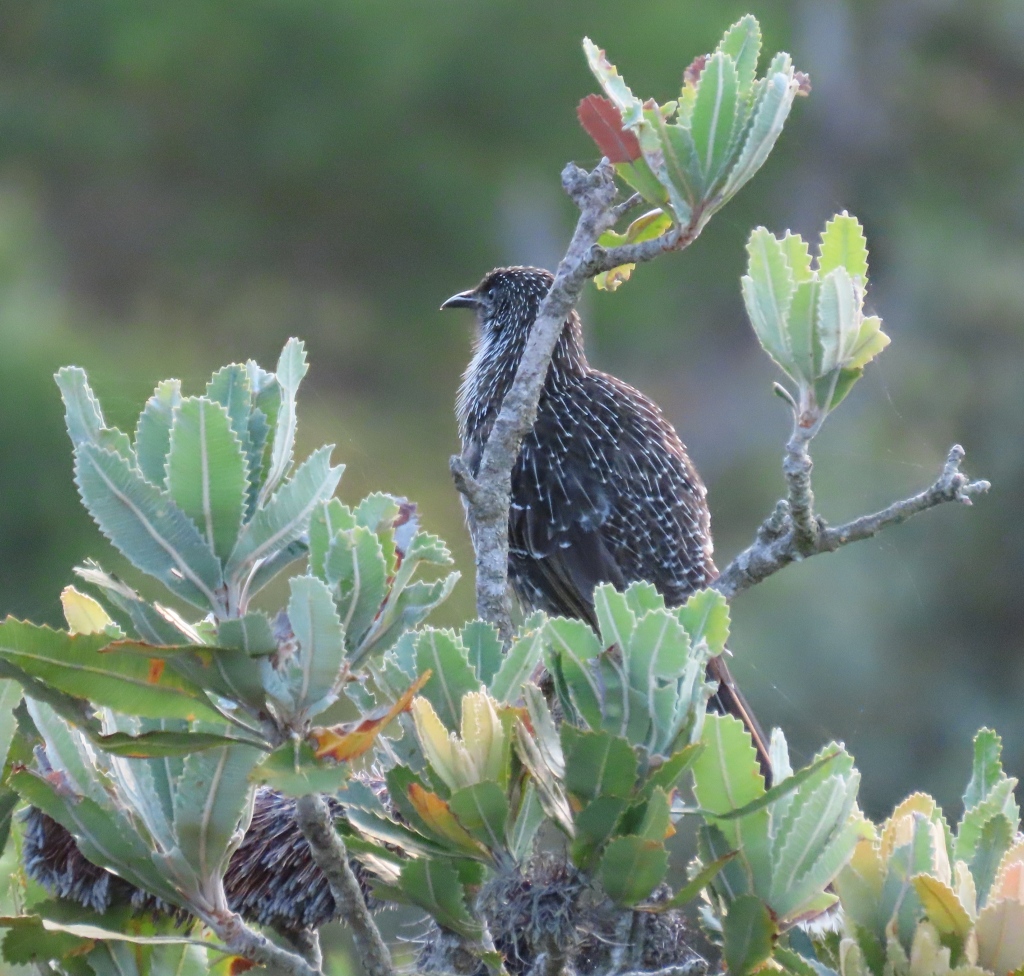
Common name: Little Wattlebird
Scientific name: Anthochaera chrysoptera
Approximate length: 30 cm
Date spotted: 17 February 2024 (summer)
Location: Dobroyd Head Track, Balgowlah, New South Wales, Australia: 33°48’33.2″S 151°16’14.1″E
Soft colours of a young Little Wattlebird
This bird was busy gathering food on an Old Man Banksia tree (Banksia serrata). It has a small insect in its beak:

I think the bird is a Little Wattlebird, though others that I’ve seen have been darker and greyer in colour. Perhaps it’s a juvenile. I considered an oriole, but the stripes on this bird’s chest are more like those of a wattlebird than an oriole, and the shapes of the beak and head are closer to those of a wattlebird too.

Little Wattlebirds don’t have the red wattles that give this genus its name. These birds are classified as honeyeaters, but like most honeyeaters they’ll grab a passing insect too. This bird was at Dobroyd Head, one of the pieces of land that jut into Sydney Harbour.
Here’s a view that shows more of the wings and back:

Common name: Little Wattlebird
Scientific name: Anthochaera chrysoptera
Approximate length: 30 cm
Date spotted: 11 March 2023 (autumn)
Location: Dobroyd Head Track, Balgowlah, New South Wales, Australia: 33°48’33.2″S 151°16’14.1″E
Wattlebirds’ tree bath
I’ve seen various birds dive through the treetops to clean their feathers. From the small New Holland Honeyeaters to the much larger King Parrots., they do it in the early morning to catch the dew, or after a rainfall. Today I managed to catch a couple of Wattlebirds performing their ablutions:
Common name: Little Wattlebird (see more pics of this bird)
Scientific name: Anthochaera chrysoptera
Approximate length: 30 cm
Date spotted: 20 April 2019 (Autumn)
Location: Manly Dam National Park, New South Wales, Australia: 33°46’16.5″S 151°14’53.5″E
Ninja wattlebird – now you see it now you don’t
Spot the bird:
It’s a common sight to see a Little Wattlebird on a banksia flower, digging its beak between the florets to find the nectar. I hadn’t realised until now, though, how perfectly camouflaged the bird is on the grey branches of a mature banksia, particularly when surrounded by dead flowerheads.
Here’s a closeup pic of the bird, looking supremely confident though, dare I say it, not very well groomed:
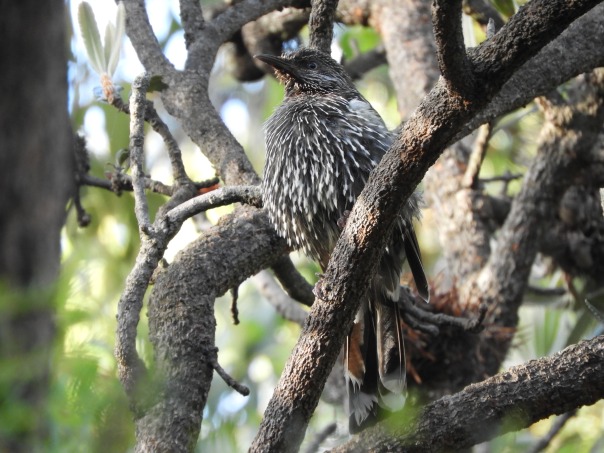
These are the flowers of the Banksia Serrata tree where I saw the bird:
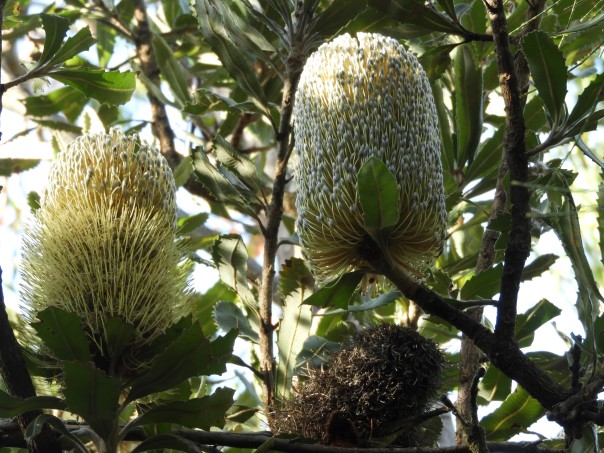
The wattlebird later moved to a bare branch to do a bit of grooming. Caught in dishevelled silhouette against the morning sun:
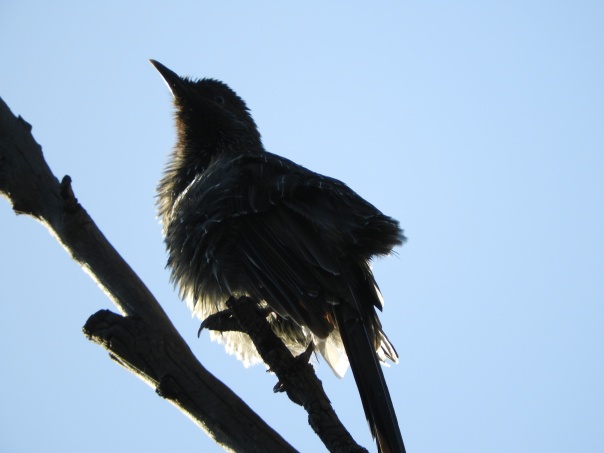
Common name: Little Wattlebird
Scientific name: Anthochaera chrysoptera
Approximate length: 30 cm
Date spotted: 26 December 2018 (Summer)
Location: Manly Dam National Park, New South Wales, Australia: 33°46’15.4″S 151°14’45.0″E
Little Wattlebird calling, mate unimpressed
A male Little Wattlebird does its best to impress (or intimidate) the bird sharing its branch. The other bird is unimpressed. In fact, its reaction seems to be, “Oh, please, are you really going to keep doing that?”
The call of a Little Wattlebird is strange. It often starts with a click-clack, as if the calling mechanism is turning over before getting into full gear. Then out comes the harsh bray that’s characteristic of the male bird. It seems to take a fair bit of effort to make this noise, as you can see in the video:
I went back to the same spot a day later, and snapped a picture of this male Little Wattlebird. It’s probably the same bird, given their fierce territoriality:
Common name: Little Wattlebird
Scientific name: Anthochaera chrysoptera
Approximate length: 30 cm
Date spotted: 7 July 2018 (Winter)
Location: Manly Dam National Park, New South Wales, Australia: 33°46’36.9″S 151°15’10.4″E



